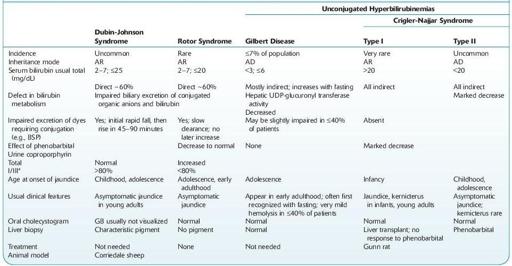Wallach's Interpretation of Diagnostic Tests: Pathways to Arriving at a Clinical Diagnosis (201 page)
Authors: Mary A. Williamson Mt(ascp) Phd,L. Michael Snyder Md

BOOK: Wallach's Interpretation of Diagnostic Tests: Pathways to Arriving at a Clinical Diagnosis
6.08Mb size Format: txt, pdf, ePub
CONGENITAL CONJUGATED HYPERBILIRUBINEMIA
DUBIN-JOHNSON SYNDROME (SPRINZ-NELSON DISEASE)
An autosomal recessive disease (gene located on chromosome 10q24) due to inability to transport bilirubin–glucuronide through hepatocytes into canaliculi, but conjugation of bilirubin–glucuronide is normal. Characterized by mild chronic, recurrent jaundice. May have hepatomegaly and right upper quadrant abdominal pain. Usually is compensated except in periods of stress. Jaundice (innocuous and reversible) may be produced by estrogens, birth control pills, or last trimester of pregnancy; may resemble mild viral hepatitis.
Laboratory Findings
See Table
5-14
.

Histology
: Liver biopsy shows large amounts of yellow-brown or slate-black pigment in centrolobular hepatic cells (lysosomes) and small amounts in Kupffer cells.

Core laboratory
: Serum total bilirubin is increased (1.5–6.0 mg/dL); rarely ≤25 mg/dL during intercurrent illness; significant amount is conjugated. Normal in heterozygotes. Other liver function tests are normal. No evidence of hemolysis. Urine contains bile and urobilinogen.

Other
: Urine total coproporphyrin is usually normal, but approximately 80% is coproporphyrin I (normally 25% is coproporphyrin I and 75% is coproporphyrin III); diagnostic of Dubin-Johnson syndrome. Not useful to detect individual heterozygotes. Fecal coproporphyrins are normal. BSP excretion is impaired with late (normal at 45 minutes; increased at 90 and 120 minutes); virtually pathognomonic but is no longer performed.
TABLE 5–14. Differential Diagnosis of Hereditary Jaundice with Normal Liver Chemistries and No Signs or Symptoms of Liver Disease

AD, autosomal dominant; AR, autosomal recessive; BSP, sulfobromophthalein; GB, gallbladder; UDP-glucuronyl transferase, uridine diphosphate?glucuronosyl transferase.
*Normally coproporphyrin III, 75% of total.
ROTOR SYNDROME
Autosomal recessive, familial, asymptomatic, benign defective uptake, and storage of conjugated bilirubin and possibly in transfer of bilirubin from the liver to bile or in intrahepatic binding; usually detected in adolescents or adults. Jaundice may be produced or accentuated by pregnancy, birth control pills, alcohol, infection, or surgery.
See Table
5-14
.
CAUSES OF UNCONJUGATED HYPERBILIRUBINEMIA
UNCONJUGATED BILIRUBINEMIA
Causes
Increased destruction of RBCs
Isoimmunization (e.g., incompatibility of Rh, ABO, other blood groups)
Other books
Temple of the Traveler: Empress of Dreams by Scott Rhine
The Complete Enderby by Anthony Burgess
Hunter by Night by Staab, Elisabeth
Relics by Mary Anna Evans
Intimate by Jason Luke
More Than a Score by Jesse Hagopian
Cold Bullets and Hot Babes: Dark Crime Stories by Arlette Lees
A Dangerously Sexy Affair by Stefanie London
Seven Days To Brooklyn: A Sara Robinson Adventure by Christopher Westley
His Indecent Proposal by Lynda Chance
